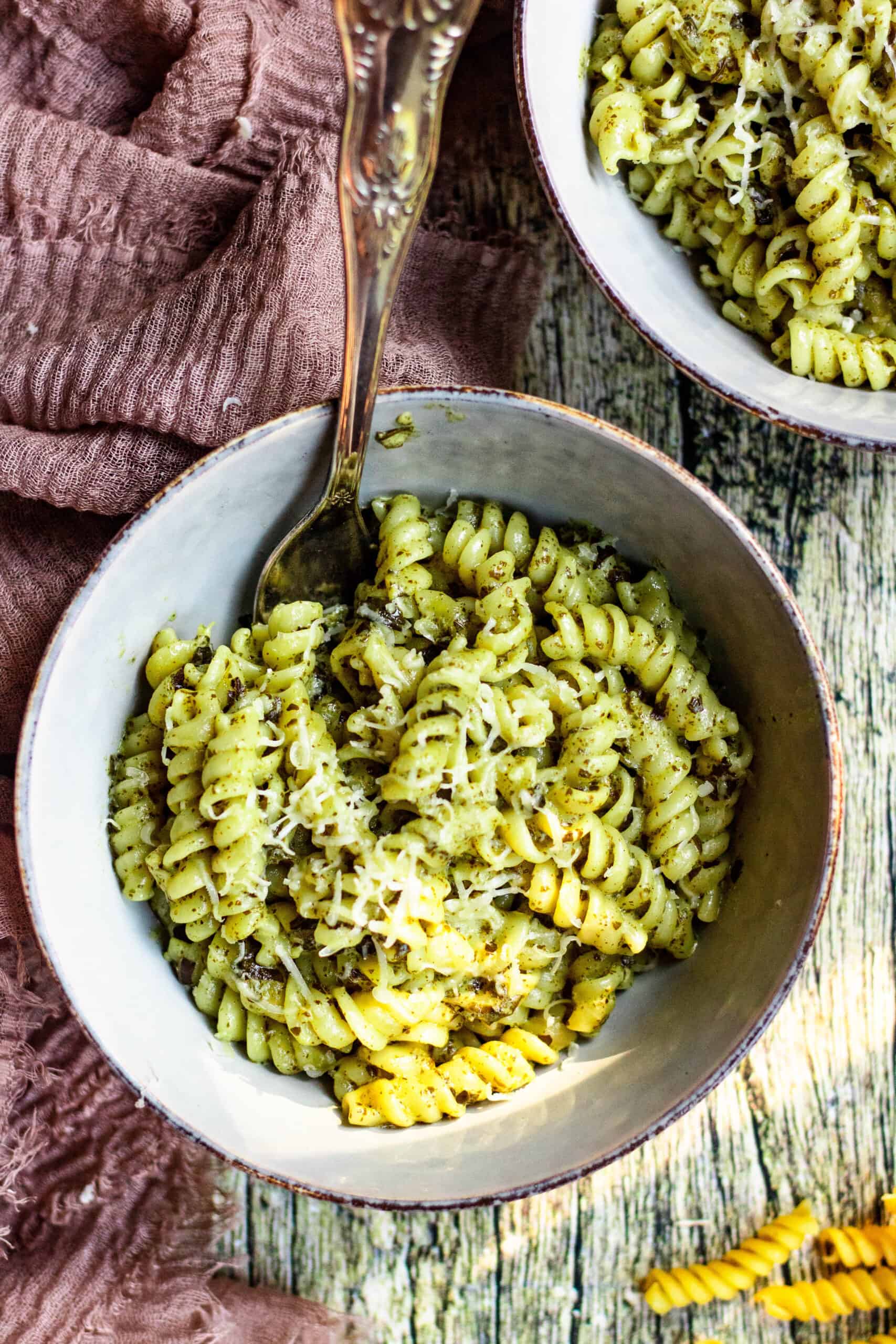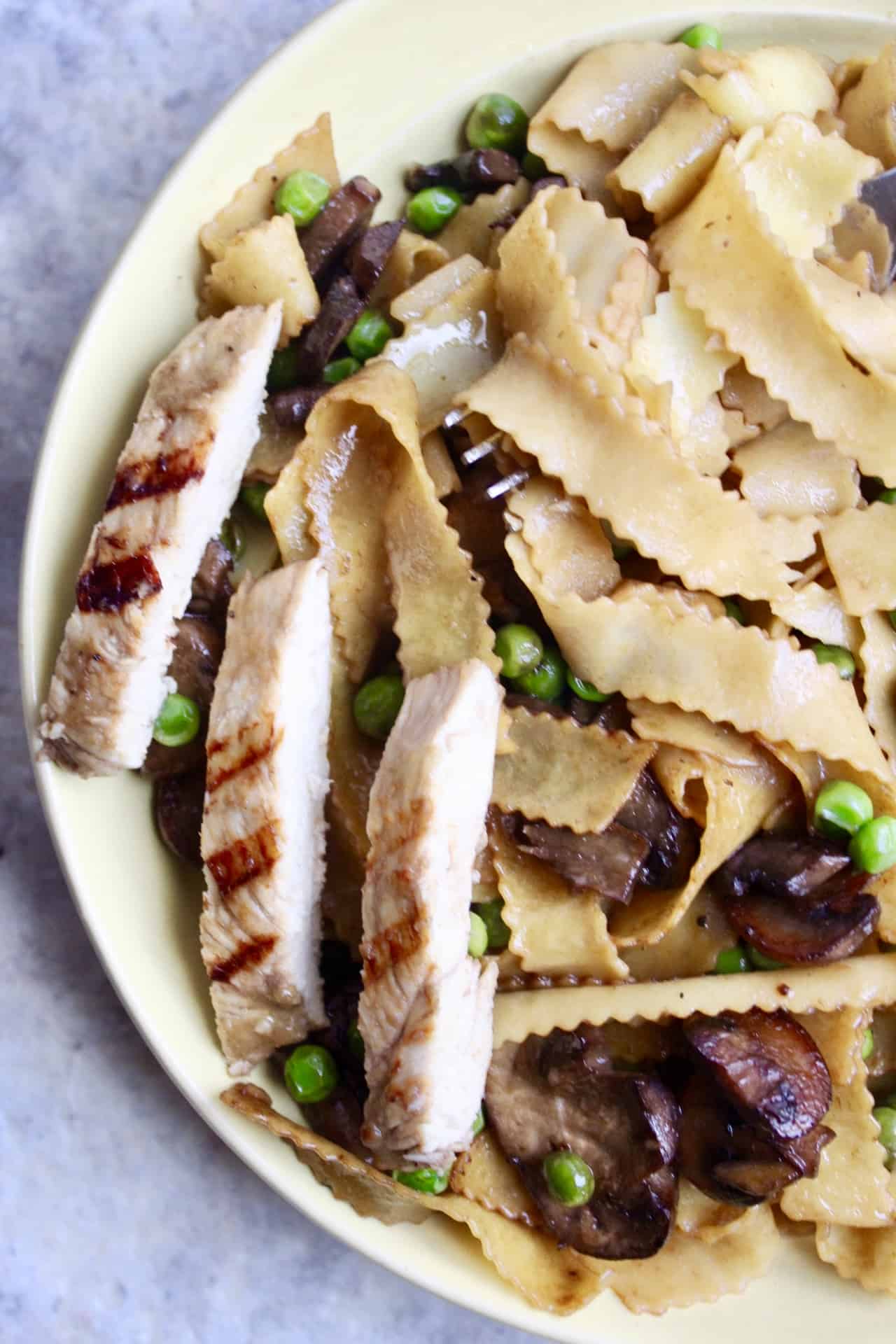Dry pasta is a staple food for a reason. It’s easy to grab a box of pasta from the grocery store and it can sit in your pantry or cupboard for a long time – even years!

If you’ve acquired a few extra bags of dry pasta recently but you don’t have any plans to cook it up right away, you may be asking yourself–does dry pasta go bad? The short answer is yes… eventually.
Read on for the best tips to preserve your pasta–or learn when it’s time to say goodbye!
Dry Pasta Vs Fresh Pasta
Before we jump into expiration dates, it’s important to note there are two schools of pasta that you can purchase at the grocery store–fresh pasta and dry pasta.
What is Fresh Pasta?

Fresh pasta is often made with eggs and flour and spread into very thin sheets before being cut into shapes and packaged. Fresh pasta also includes any noodles you make by hand at home.
This type of pasta is still slightly moist when it is packaged, and the fresh ingredients make it susceptible to bacteria. In fact, it should really be used within two days of purchasing.
The good news is, you should have no problem using fresh pasta right away. It cooks up in just a few minutes and easily soaks up whatever sauce it is placed in. It’s perfect for a super quick weeknight meal. You can pour your sauce of choice on top and be ready to go in no time!
As with most fresh ingredients, it will have more flavor than dried pasta and the texture is different as well.
If you did purchase fresh pasta and don’t have plans to cook it, you can store it in the freezer for up to two months. You can leave it in whatever packaging it came in or wrap it in a double layer of aluminum foil to protect it from freezer burn.
What is Dry Pasta?

Dry pasta, on the other hand, is usually made by dough being pushed through molds to achieve the shapes you’re familiar with like spaghetti or fettuccine. It’s then dried out for packaging. It’s popular around the world because of its long shelf life.
The drying process creates an environment where bacteria cannot grow, so pasta is able to sit on a shelf for months or even up to a year without going bad.
Dry pasta is good for dishes like soups or casseroles where it has the chance to cook slowly and soak up flavor from the sauce. Of course it can also be used for quick meals too as it only takes about 15 minutes to be cooked al dente.
How Long Does Dry Pasta Last?

Dry pasta can last for up to a year from the time you purchase it if stored properly and even up to two years in its original packaging.
Dry, packaged pasta comes with a best by date listed on the package. While this date is important and should not be ignored, it is good to know the best by date is the manufacturer’s best guess for how long the pasta will retain its quality–not its safety. If you are hoping to use the pasta a few days after the date listed on the package, it is probably safe to do so.
Dry pasta won’t usually go “bad” in the way that fresh produce or meat does, but the biggest problem to worry about is it losing flavor the longer it sits.
How Can You Tell If Your Pasta is Bad?
With fresh or cooked pasta, you’ll know just by looking at it or smelling it if it has gone bad. Any discoloring, mold growth or bad smells are signs of spoilage. It should not be kept longer than a few days.
Dry pasta may be a bit trickier but here are a few ways to tell if it should not be used:
Look at It
Obviously, if there’s any mold growing on your pasta or if it feels slimy–throw it away. This may happen if moisture has gotten to the noodles and has had a chance to sit. It shouldn’t happen if your pasta is kept in an airtight container.
You may also be concerned about your pasta if there is a noticeable color difference compared to dry pasta you just purchased. Any white spots are signs of mold. To be safe, throw it away.
The best way to tell if pasta has gone bad by looking at it is to see if it is cracked or brittle. Old pasta may start to crack and crumble, and then it’s no good.
You should also throw away dried pasta if there are any signs of pantry bugs in or on the packaging. Pests are the biggest threat to your dried pasta which is why storing it in an airtight plastic or glass container is a good idea.
Smell It
If pasta smells rancid, it will taste rancid too. Don’t risk it.
Check the Expiration Date
Pasta, like all other food products, has a best by date listed on the packaging. This is not necessarily the date the food is no longer edible–but it’s the manufacturer’s best guess for when the pasta’s quality will begin to deteriorate.
If your pasta is past the best by date, it may still be safe to eat, but it may not taste its best. Do a thorough check before proceeding.
Cook Some
If you can’t locate an expiration date and don’t trust your sense of smell, try cooking a small amount of pasta. Pasta is easy to cook in boiling water for about 10 minutes and you’ll know during the cooking process if it looks right or not. If it’s not cooking up normally, it’s not worth eating.
The Best Way to Store Pasta for a Longer Shelf Life
Storing Dry Pasta

Dry pasta should be stored in a dry, dark place at room temperature, away from any moisture, heat or direct sunlight. A dry area like a pantry or cupboard is best.
Be sure and place your pasta in an airtight container to protect it from any pantry pests that may be attracted to the wheat. There are many plastic storage containers you can purchase or glass mason jars work well.
It is not necessary to store dried pasta in the fridge or freezer. It won’t extend the pasta’s shelf life and may actually be harmful. The cool temperatures may increase the moisture in the air and contaminate your dried pasta.
Storing Fresh Pasta
Fresh or homemade pasta should be stored in the refrigerator and should be eaten within two days. You can extend its shelf life by putting it in a freezer-safe container or a double layer of aluminum foil in the freezer for up to two months. Be sure and check for any signs of freezer burn before enjoying.
Cooked leftover pasta can be kept in your refrigerator for up to five days in an airtight container or two months in the freezer. If you are saving noodles without any sauce it’s a good idea to add some olive oil to the container to keep your noodles from clumping or sticking together.
If you have already added sauce to your pasta leftovers, you do not need to add any oil, but you may want to add a small splash of water before reheating as the noodles will soak up moisture from the sauce.
FAQs
Yes, you can get sick from eating expired pasta. If it’s cooked or fresh pasta that you’re eating, you may be exposed to a foodborne pathogen like E. coli or salmonella. This can cause food poisoning, diarrhea or vomiting.
Foodborne illness is also a possibility if you consume expired dry pasta, but it’s not likely because of the zero moisture content. If your dry pasta is expired, you will most likely just miss out on flavor and texture.
Eating dry pasta without cooking it will likely not make you sick, because bacteria will likely not survive in the dry noodles. However, it may be difficult for your body to digest, and this can cause some serious discomfort.
It’s also difficult for your teeth to chew dry noodles and may damage the enamel on your teeth. Some pieces of dried noodles may be sharp and damage your digestive tract as you swallow. In general, it’s not a good idea.
Eating fresh, uncooked pasta is not recommended as it may contain raw eggs which can breed bacteria like E. coli and salmonella.
Interesting Facts About Pasta
- Many different countries around the world have their own version of pasta. Pasta was thought of as an Italian staple but it was actually first produced in China or Greece.
- There are more than 600 different types of pasta produced all over the world.
- Spaghetti noodles are the most popular noodle in America.
- Most dried pastas are made with only semolina flour and water.
If you’re looking for ways to use the dry pasta in your pantry, check out some of my favorite pasta recipes:
Lemon Ricotta Pasta

Shrimp and Ricotta Pasta Bake

Instant Pot Pizza Pasta Bake

Bang Bang Shrimp Pasta

Creamy Pesto Bake

Bucatini Cacio e Pepe

Vegemite Pasta








Leave a Reply